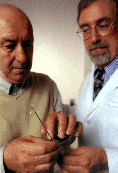Liver Tumors Can't Take the Heat
 Dr. Steven A. Curley explains a new procedure known as radiofrequency
ablation for the treatment of liver tumors to patient Marcos Bertoldi.
Dr. Steven A. Curley explains a new procedure known as radiofrequency
ablation for the treatment of liver tumors to patient Marcos Bertoldi.Liver Tumors Can't Take the Heat
 Dr. Steven A. Curley explains a new procedure known as radiofrequency
ablation for the treatment of liver tumors to patient Marcos Bertoldi.
Dr. Steven A. Curley explains a new procedure known as radiofrequency
ablation for the treatment of liver tumors to patient Marcos Bertoldi.Return to Spring 98